The UN created World Bee Day in 2018 to highlight the importance of pollinators and the threats that they face. This year Ukraine’s bees and beekeepers face a new kind of threat: a war of aggression waged by the Russian Federation. The war has not only destroyed apiaries, forced tens of thousands of beekeepers to abandon their homes and cut other beekeepers off from their bee yards, but has also disrupted markets, pollination, honey bee research and the planting of nectar-bearing crops. Instead of “celebrating the diversity of bees and beekeeping systems” – the FAO’s 2022 Bee Day theme – Ukrainian beekeepers, breeders, scientists, ministry officials and an apitherapist gathered on Zoom for a meetup called “Beekeeping and War: Challenges and Ways to Overcome Them.” The event was organized by the Prokopovych Beekeeping Institute (PBI) (The official name is National Scientific Centre “Prokopovych Institute of Beekeeping.”) and the NGO Foundation of Women Beekeepers (FWB) and was hosted by Leonora Adamchuk, associate professor at National University of Life and Environmental Sciences of Ukraine and cofounder of FWB. First Deputy Minister of the Ministry of Agrarian Policy and Food, Taras Vysotsky, opened the event and assured listeners of his support. Presenters’ topics ranged from monitoring war-created toxins, to attempts to keep research going, to advice on war-time apitherapy. All were united by a concern about the war’s impact on the livelihoods of Ukraine’s estimated 46 thousand officially registered beekeepers, and revenues from the production of honey – some 70,000 tons of which are exported each year. Tanya listened in as an anthropologist who studies the history of breeding and conserving aboriginal honey bee breeds in Ukraine.
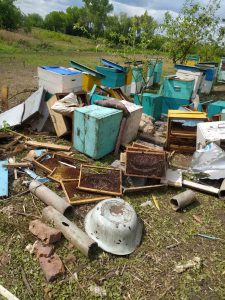
Photo 1. Destroyed apiary in the village of Mospanove in the Kharkiv Region.
The meet-up’s first half featured presentations by the director of PBI, the head of Ukraine’s Beekeeping Association and beekeepers who had to flee and those who have been able to stay. Volodymyr Postoienko, director of the PBI was blunt in his introductory remarks: “In recent years, we have had to deal with different challenges such as the pandemic and now Russian fascists. They destroy infrastructure, civilians and agrarian livelihoods. Their main goal is to pollute the environment… they destroy our productive resources to cause famine here and in the world.” His colleague from the National Academy of Agrarian Sciences, Professor Ostap Zhukorsky, elaborated. Previously he and others had studied the impacts pesticides and herbicides on bees partly in connection with the rise in incidents of mass honey bee die-offs and conflicts they had provoked between farmers and beekeepers. However, missile strikes on industrial and civilian infrastructure have released new kinds of toxins into land, air and water on an entirely different scale. Airborne toxins land on bees. They also enter ground water, are ingested by the bees when they consume plants’ nectar and could accumulate in wax, honey and other bee products. Toxins’ presence may make bee products unsafe to consume therefore ineligible for export to the European Union, one of Ukraine’s largest markets. Professor Zhukorsky stressed the urgency of monitoring the movement of pollutants through the environment and implored audience members and other farmers to provide samples for testing before consuming or selling them.
Other talks outlined the ways the war has affected beekeepers, most of whom have 50 or fewer hives. Volodymyr Stretovych, Head of Ukraine’s Beekeeping Association, described how fuel shortages, check points and other military restrictions on mobility have curtailed beekeepers’ ability to transport apiaries to nectar flows in areas adjacent to battle zones. Leonora Adamchuk talked about the FWB’s activities before the war, including its recruitment of 60 women beekeepers from 18 different administrative regions. She also presented data from her survey of women beekeepers throughout Ukraine about how the war has affected them. Seventeen percent had lost apiaries and 17% had left the country. One of these was Iryna Vasylieva, a beekeeper from the town of Svatove in the Luhansk Region. In her talk, Iryna described how before the invasion she had expanded her apiary to 50 hives, begun developing agrotourism with a grant from the United Nations Development Program and been selected to be part of a network of demonstration farms. However, when fields around her town were mined and bombardment began after February 24, she decided to leave for Denmark. FWB survey data showed that an additional 20% of women beekeepers were forced to leave their homes while 66% of women beekeepers indicated that their business had been affected in a significant way.
While other FWB members remained at home they dramatically reoriented their activities. After a week of “tears and denial,” founder of the Power of Nature Apiary in the town of Kremenchuk, Poltava Oblast Maria Moseichuk, established a volunteer group which set up a shelter and cafeteria for internally displaced people. She connected with humanitarian networks and helped distribute food and medicines to her shelter and to two orphanages. Like many other beekeepers she has donated honey, money and other bee products to the army. She also teaches displaced children about bees and candle-making and manages her apiary which is located 20 km from her home. Nowadays, however, due to fuel shortages stemming from missile strikes on oil terminals, Maria bikes rather than drives. She wrapped up her presentation jokingly on an optimistic note as she described her efforts to make her apiary organic by creating organic fertilizer: “I think there will be a good harvest thanks to my bees and my compost.”
Scientists from different backgrounds – biology, chemistry and agrarian sciences – also play crucial and varied roles in supporting Ukraine’s beekeeping industry. The second half of the meet-up featured presentations by specialists from Kharkiv, Kyiv, Odesa, Poltava and Transcarpathia who talked about the challenges of diversifying markets, keeping breeding programs going, monitoring apiaries in a conflict zone and pursuing their research projects. Several presenters spoke about breeding and researching Ukraine’s aboriginal honey bee breeds – the Carpathian (Apis mellifera carnica var. ukrainica carpatica), the Ukrainian Steppe (Apis mellifera sossimai) and the Polissian (Apis mellifera var. polissica) – which is one of the key tasks of the PBI. Viktor Papp of the PBI’s Carpathian Bee Department explained that Transcarpathian-based honey bee researchers have been able to use isolated mating areas to carry out selection work because missile strikes are infrequent. By contrast, because of military prohibitions on using watercraft on the Dnipro River, Hanna Hrechka and Tetiana Senchuk of the Ukrainian Steppe Bee Department in Hadiach, Poltava, have been unable to continue their selection work because they can’t access the isolated mating area on an island in the Dnipro.
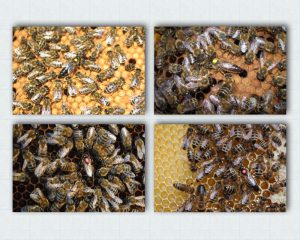
Photo 2. Four types of Carpathian honey bees from left to right, top to bottom: Vuchkove, Hoverela, Rakhiv, Sinivir
Genetic research about Ukrainian Steppe bees has also been disrupted by war because of the closure of Ukraine’s airspace. Professor Ihor Kostikov of Kyiv National University and the Prokopovych Institute explained that whereas the genome of Carpathian bees has been fully sequenced, the Ukrainian Steppe bee’s has not. Without this sequencing the question of whether it is a distinct subspecies (Apis mellifera sossimai) or a population of the Apis mellifera macedonica subspecies cannot be fully answered. Professor Kostikov had been about to send the sample abroad for sequencing when the war began. Uncertainty about this bee’s taxonomic identity means that some beekeepers – particularly those who import other kinds of bees such as Carniolan or Buckfast bees – can dispute the value of conserving Ukrainian Steppe bees. Nevertheless, Ihor Kostikov responded with an emphatic “yes” to Leonora Adamchuk’s question about whether it is important to continue conserving them despite not definitively knowing their identity. Honey bees’ extreme polyandry and aerial mating practices mean hybridization happens easily and is difficult for beekeepers to fully control. Kostikov reminded the audience that over the long term, hybridization leads to the loss of the rich diversity in sex alleles of a particular population and eventually their existence as a distinct population. Data from genetic sequencing can help provide additional arguments for conserving Ukrainian Steppe bees and enforcing regulation regarding their use in particular territories. Leonora Adamchuk noted that Polissian bees (Apis mellifera var. polissica) have survived only in the Chornobyl Exclusion Zone and have not been studied at all.
While Ukrainian and foreign observers are well-informed about the size of Ukrainian honey exports and their contribution to the Ukrainian economy, the significance of the international export of queens to the European Union, Middle East, Central Asia, Russia and Canada is less well-known. Stepan Kerek, head of the Carpathian Department of the PBI, explained that until February 24, Russia was one of the largest export markets for Carpathian queens and bee packages while bees bound for Central Asia have typically transited through Moscow. He reminded the audience that the export of queens and packages from Transcarpathia to Russia began in the 1970s with the development of a queen breeding program and that the region does not produce much honey. The loss of Russian and Central Asian markets has therefore been a shock to the region’s 1,036 beekeepers. Stepan argued that it is imperative that the Carpathian breeders undertake a “derussification” of their trade and proposed that Canada could replace Russia. This is not only because Canadian demand for queens and packages is large, but also because in 2020 Canada approved the import of Ukrainian queens. Ukrainian breeders have had success in exporting queens to Canada and hope that the packages could be approved soon.
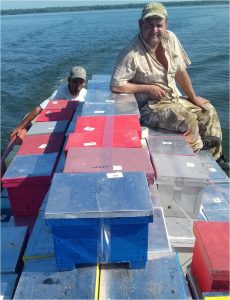
Photo 3. Trip to an isolated mating area on an island in the Dnipro River
Odesan Agrarian University researchers Halyna Skrypka (in Odesa) and Olena Ievtushenko (in Kharkiv) both had their work interrupted but have nevertheless continued to gather data and envision future research. In spite of limitations that constant bombardment and the occupation of part of Kharkiv Region imposed on her research, Olena presented data about the scale of destruction and raised questions for monitoring and research (Olena heads the bee diseases sector of her university’s Experimental and Clinical Veterinary Medicine Research Centre). Because up to 30% of Ukrainian beekeepers don’t register their apiaries, it is difficult to provide precise data about the loss of hives; at the same time beekeepers who lost apiaries “may not be emotionally or practically able to get in contact.” While showing a picture of destroyed hives, Olena explained that in Kharkiv, 76.45% of apiaries suffered losses, a figure that included colonies, equipment and storage facilities. Olena proposed that once the war is over and the territory de-occupied, researchers should focus on two issues: first, compare hives that are managed by a beekeeper with those that have been abandoned; second, compare bee colonies that have experience shock waves from explosions with those who have not.
Olena’s Odesan colleague Halyna, who had no access to her lab for two months, spoke about “the everyday life of a scientist during war” and how she sought to “do her part.” When her lab closed she decided to continue her investigations at home using a 1935 microscope inherited from her great-grandmother who had taught at Odesa’s Medical University. A package of honey sent by a beekeeper in Ternopil oblast just prior to the invasion became her focus. Although she was unable to perform a full analysis of the samples, she was able to identify pollen types in the honey with the help of a pollen atlas. Her lab has recently reopened but resources are extremely limited. Nevertheless, she said, “We should do the work that we love, that inspires us and that calms us down. Scientists should do their research; science is the future and the future depends on us.”
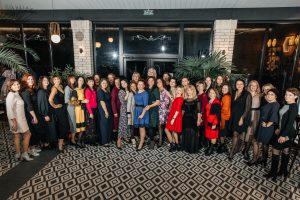
Photo 4. Forum of the Federation of Women Beekeepers Fall 2021
Apitherapist and psychologist Svitlana Volynets addressed her fellow beekeepers as human beings with bodies and souls in a presentation about the healing properties of propolis and other bee products. She listed the types of emotions that accompany war-induced stress – alarm, shame and sorrow – and the biological and psychological effects of living with extreme stress for more than 28 days. She reminded listeners that this kind of stress elevates cortisol levels which removes calcium from bones, undercuts protein synthesis, affects the release of insulin, undermines a person’s sense of their own basic need to sleep and eat and disrupts the release of hormones that enable a person to feel joy. Svitlana urged her colleagues to consume propolis-based products to reduce depression, and royal jelly – which is rich in B6, B12, and folic acid – to lower cortisol levels. She told them to practice another tried and true form of Ukrainian psychotherapy – singing. “By looking after yourselves,” she said, “you will be better equipped to respond to unpredictable situations, better able to help others in need and will avoid the feeling of victimhood.”
Attendees filled the Zoom chat with greetings, suggestions, words of support and expressions of gratitude to the organizers for creating an opportunity to gather. The 2022 FOA World Bee Day presentation which some Ukrainians joined afterwards celebrated the diversity of bees and beekeeping systems with beautiful videos and slide presentations from around the world. In Ukraine, World Bee Day enabled Ukrainian beekeepers and researchers to gather together to affirm their ability to survive, resolve problems, envision a future and defy the Russian military’s campaign to destroy them and their land. Over and over again participants addressed each other with versions of Leonora Adamchuk’s words: “We are on our land; we will be victorious.”
Tanya Richardson is Associate Professor in the Anthropology Program and the Department of Global Studies at Wilfrid Laurier University, Canada. Email: [email protected]
Leonora Adamchuk is Associate Professor in the Department of Standardization and Certification of Agricultural Products at the National University of Life and Environmental Sciences, Ukraine. Email: [email protected]
]]>By: Shana Archibald
Ingredients
□ 2 cups warm water (105-115°F degrees)
□ 1 tablespoon active dry yeast
□ ¼ cup honey
□ 2 teaspoons salt
□ 2 tablespoons oil (canola or vegetable)
□ 4-5½ cups all-purpose or bread flour
Directions
Step 1
Prepare the dough: In a large bowl or stand mixer, add the yeast, water and a pinch of honey (¼ teaspoon). Allow to rest for 5-10 minutes until foaming and bubbly. (This is called “proofing.” If it doesn’t foam, the yeast is no good, and you need to start over with fresh yeast)
Step 2
Add remaining honey, salt, oil and 3 cups of flour. Mix to combine.
Step 3
Add another cup of flour and mix to combine.
Step 4
With the mixer running, add more flour, ½ cup at a time, until the dough begins to pull away from the sides of the bowl. The dough should be smooth and elastic, and slightly stick to a clean finger, but not be overly sticky. Add a little more flour, if needed.
Step 5
Knead the Dough: Mix the dough for 4-5 minutes on medium speed (or knead with hands on a lightly floured surface for 5-8 minutes).
Step 6
First Rise: Grease a large bowl with oil or cooking spray and place the dough inside, turning to coat.
Step 7
Cover with a dish towel or plastic wrap and allow to rise in a warm place until doubled in size, about 1½ hours.
Step 8
Spray two 9×5” bread pans with cooking spray on all sides. (I also like to line the bottom of the pans with a small piece of parchment or wax paper, but that is optional)
Step 9
Punch the dough down well to remove any air bubbles.
Step 10
Divide into two equal portions.
Step 11
Shape each ball into long logs and place into greased loaf pans.
Step 12
Second Rise: Spray two pieces of plastic wrap with cooking spray and lay them gently over the pans.
Step 13
Allow dough to rise again for 45 minutes to one hour, or until risen 1 inch above the loaf pans.
Step 14
Gently remove covering.
Step 15
Bake: Preheat oven to 350°F.
Step 16
Bake bread for about 30-33 minutes, or until golden brown on top.
Step 17
Give the top of a loaf a gentle tap; it should sound hollow.
Step 18
Invert the loaves onto a wire cooking rack.
Step 19
Brush the tops with butter and allow to cool for at least 10 minutes before slicing.
Step 20
Once cool, store in an airtight container or bag for 2-3 days at room temperature, or up to 7 days in the refrigerator.
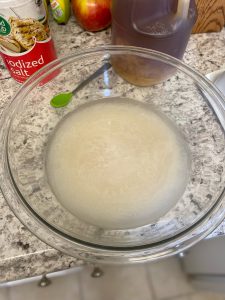
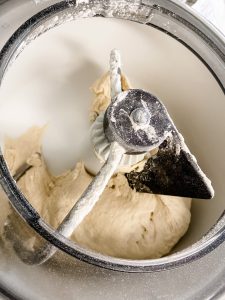
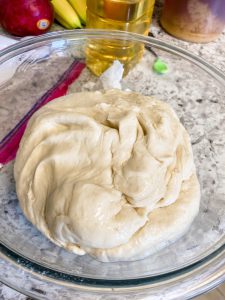
How To Submit:
Email your images to [email protected]
Use the subject “Image Gallery”
Please include in your email:
– The image as an attachment (we will not consider it if it is embedded)
– Your First and Last name
– Your mailing address
– Your renewal code (if you know it)
If your image is chosen:
For the Gallery:
You will get three months added to your current subscription.
For the Cover:
You will get twelve months added to your current subscription.
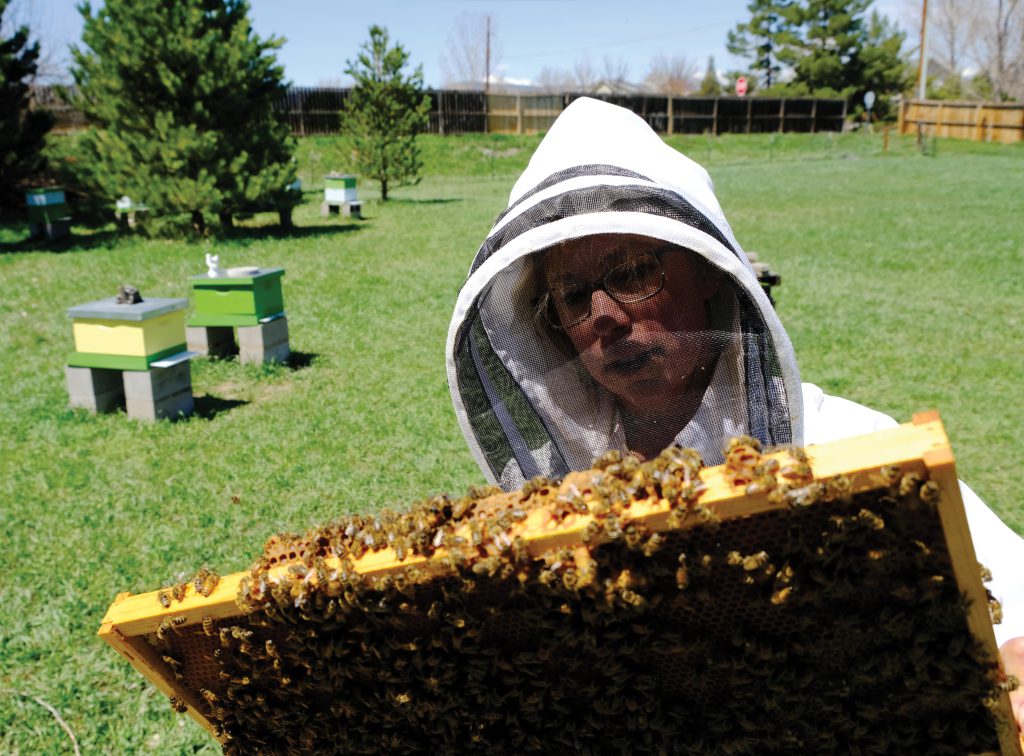
Submitted by Jeff Server
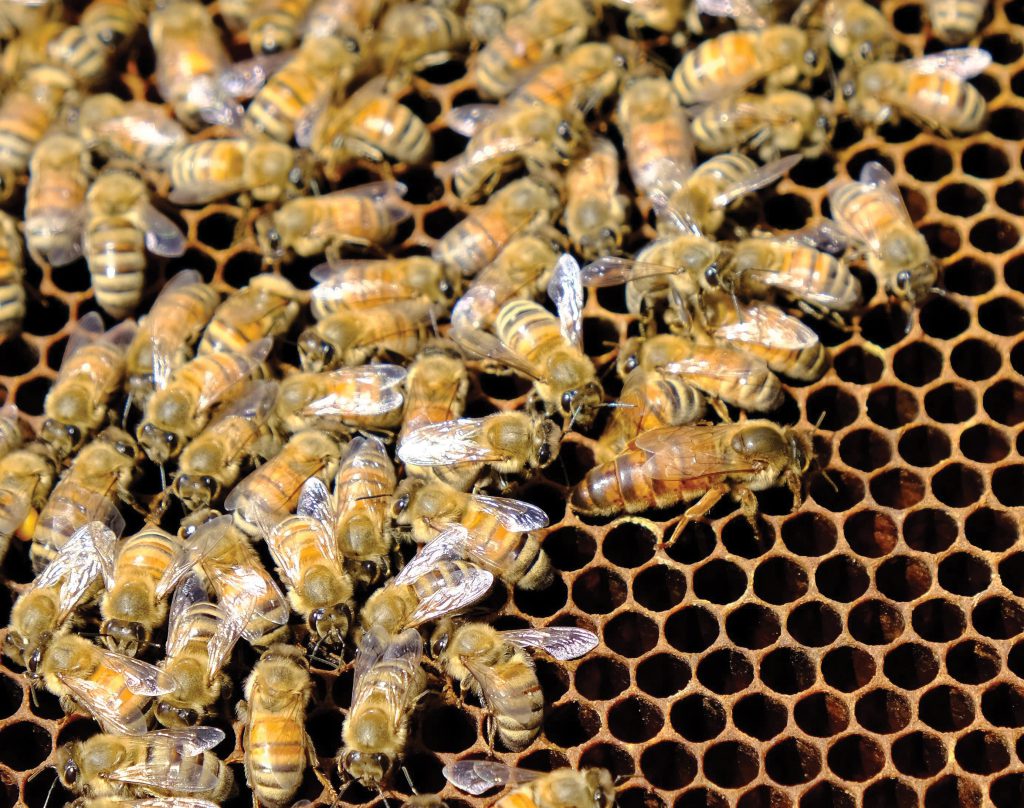
Submitted by Jeff Server
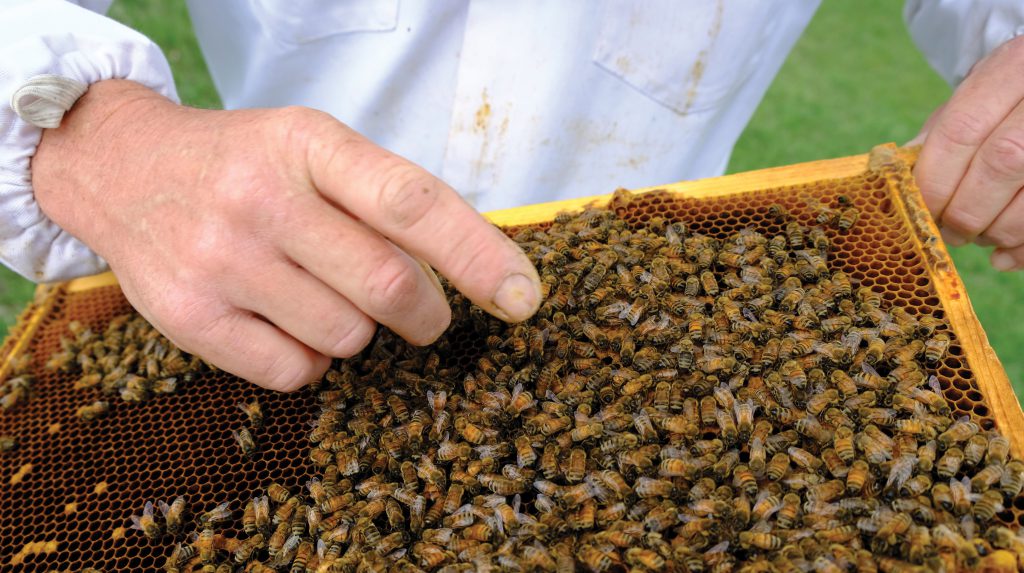
Submitted by Jeff Server
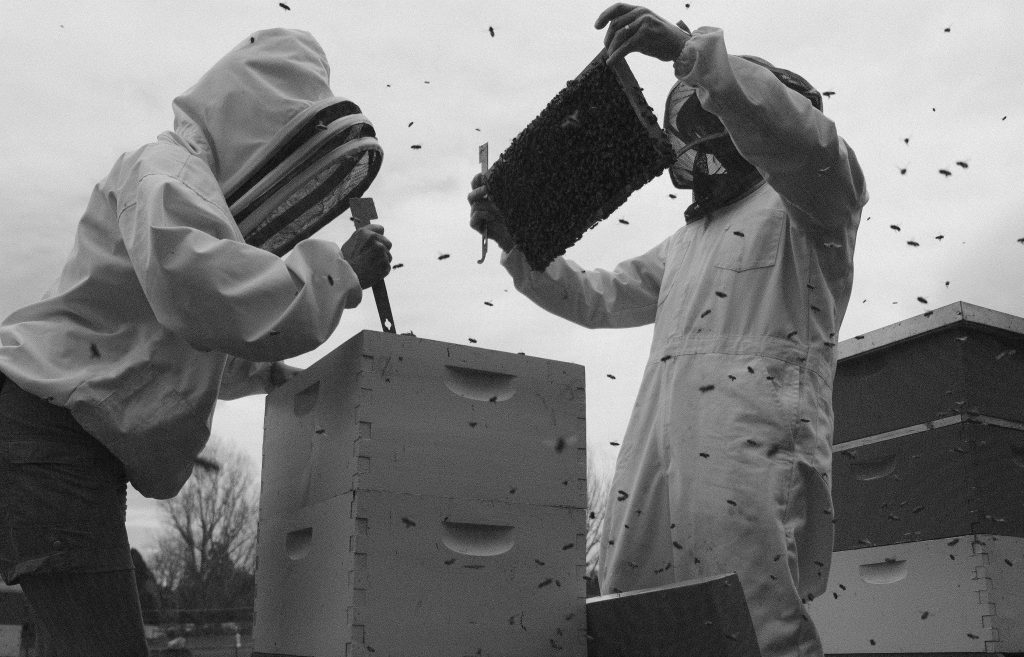
Submitted by Jeff Server

They landed on my bait hive, but it took them most of the night to go in. Submitted by L Eric Smith
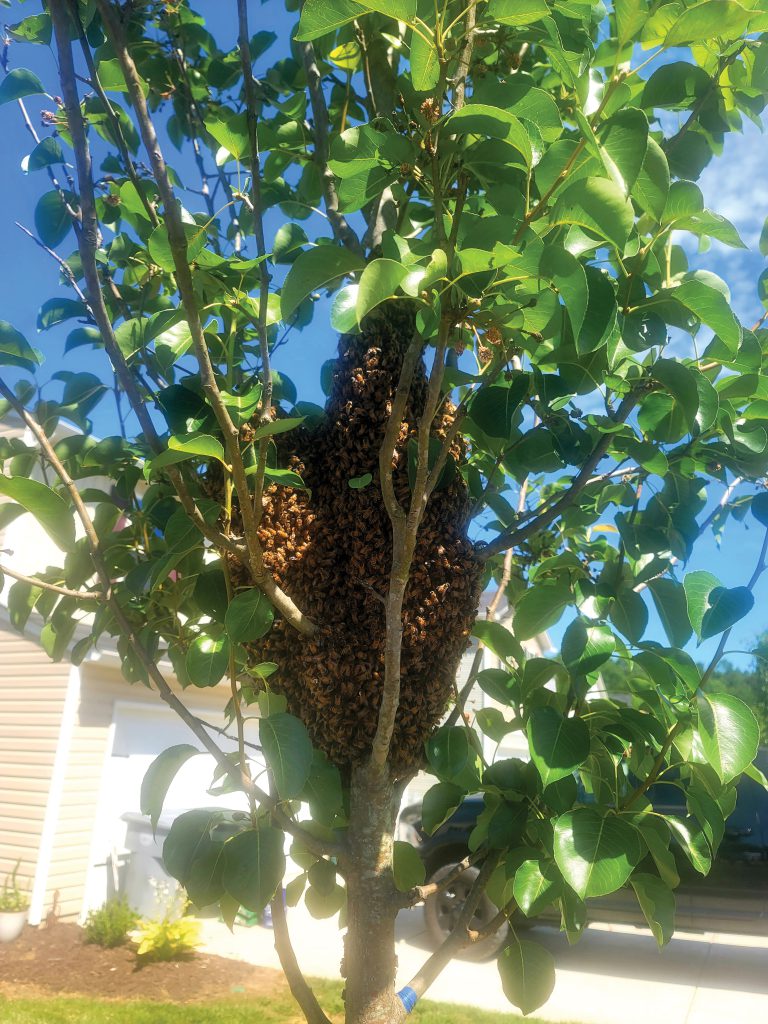
Swarm call in the suburbs. Submitted by Victor Gill
Honey Bee Authority Dr. Eric Mussen Passes
Celebrated honey bee authority Dr. Eric Carnes Mussen, an internationally known 38-year California Cooperative Extension apiculturist and an invaluable member of the UC Davis Department of Entomology and Nematology faculty, died Friday, June 3 from liver cancer. He was 78.
Dr. Mussen, a resident of Davis, was admitted to a local hospital on May 25. He was diagnosed with liver cancer/failure on May 31 and returned to the family home June 1 for hospice care. He passed away the evening of June 3.
“Eric was a giant in the field of apiculture,” said Steve Nadler, professor and chair of the UC Davis Department of Entomology and Nematology. “The impact of his work stretched far beyond California.”
Dr. Mussen, known to all as “Eric,” joined the UC Davis entomology department in 1976. Although he retired in 2014, he continued his many activities until a few weeks prior to his death. For nearly four decades, he drew praise as “the honey bee guru,” “the pulse of the bee industry” and as “the go-to person” when consumers, scientists, researchers, students and the news media sought answers about honey bees.
“Eric’s passing is a huge loss,” said longtime colleague Lynn Kimsey, director of the Bohart Museum of Entomology and a UC Davis distinguished professor of entomology. “He was always the go-to person for all things honey bee. He worked happily with hobbyists, commercial beekeepers and anyone just generally interested.”
Colleagues described Mussen as the “premier authority on bees and pollination in California, and one of the top beekeeping authorities nationwide,” “a treasure to the beekeeping industry” and “a walking encyclopedia when it comes to honey bees.”
Norman Gary, a noted UC Davis emeritus professor of entomology who served as a faculty member from 1962 to 1994, described Eric as “by far, the best Extension apiculturist in this country.”
“Eric’s career was so productive and exciting that a book would be required to do justice for his many contributions to his profession as extension entomologist specializing in apiculture, better known as beekeeping,” Gary said. “His mission basically was facilitating productive and reciprocal communication between beekeeping researchers at UC Davis, commercial beekeeping as it affects California’s vast needs for the pollination of agricultural crops, providing helpful information to hobby beekeepers and educating the general public concerning honey bees. His great professional successes in all areas have been recognized around the world. He has received numerous awards, especially from the beekeeping industry. He was by far the best Extension apiculturist in this country!”
“In addition to professional duties, he enthusiastically tackled other projects for entomology faculty,” Gary said. “For example, he critically reviewed most of my publications, including scientific papers, books and bulletins. He worked diligently to help create the Western Apicultural Society and later served as president. (Mussen served six terms as president, the last term in 2017.) I especially appreciated his volunteering to moderate a video that historically summarized and recorded my entire 32-year career at UC Davis. And his tribute would not be complete without mentioning that he was one of my favorite fishing buddies.”
See more at https://bit.ly/3zi9Jdi
If you have been around long enough in the beekeeping industry, the name Gene Killion not only rings a bell but it also inspires awe. Gene passed away on June 19, 2022 at the age of 98. With his perennial humor, Gene claimed he was (two years younger than) a centenarian and had been keeping bees since he was five years old. Gene’s family was a member of the American Beekeeping Federation since its inception. His father, Carl Killion, began the stellar bee hive inspection program in the State of Illinois and, in 1971, Gene took over from his father. He remained on the staff until 1990 when he retired. Fifty plus years had passed since the inspection program had begun! At the height of the program, he oversaw about ten inspectors. All the pioneers in the industry were Carl and Gene’s friends.
Gene was in the U.S. Air Force during World War II. When he left, he sold his honey to his father for 5¢ a pound and his father forewarned him, “Someday you will be selling your honey for $1.00 a pound.” Again, the Killions were on the cutting edge when they began selling pollen traps, were the first to sell pollen supplements and packaged their honey in plastic. They were the first to have a stainless steel extractor from A. I. Root.
The specialty of the Killion family was section box comb honey. They had a very unique method of production and produced thousands of sections which were sold around the nation. The highlight came in 1951 when they broke the all-time record by averaging fourteen comb honey supers each from 100 hives. One hive actually produced seventeen supers. The small town of Paris, Illinois was not even aware of it as the honey would be shipped out of town within the confines of a semi.
Each year in October, HONEY WEEK is celebrated in Paris, Illinois. This commemorates the anniversary of the issuing of a bee stamp in 1980. Gene’s father Carl worked tirelessly with the U.S. post office, as did Gene, as his father aged. The Killion family has always been a well respected family in Paris, IL and continued to impact the beekeeping industry in the United States.
In the late 1940’s, Gene studied under Dr. Bert Martin of Michigan State University to enable him to be a judge of honey. Over the years, Gene was the chief judge of many national honey shows, writing several articles on how to judge honey exhibits.
With this fine history behind him, it was in 2016 that Gene was attending the American Beekeeping Federation convention in Ponte Vedra, Florida. There he was giving a presentation and met the chef. They became fast friends and Gene helped to make Sawgrass Marriott more natural-food oriented.
A cute story that was remembered by Gene is when his father, Carl, built a camper truck to drive to the bee convention down in New Orleans at the Roosevelt Hotel. It just so happened that the major league baseball convention was being held at the same time. Needless to say, Gene and his brother were mesmerized by meeting many of the ball players and getting their autographs rather than going to the bee meetings with their mom and dad.
Gene is survived by his son Mark in Paris, Illinois. Condolences can be sent to P.O. Box 96, Paris, IL 61944.

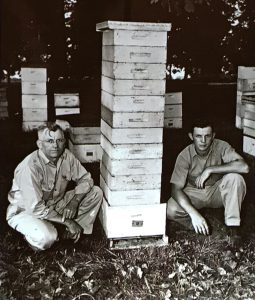
By: James E. Tew
Beekeepers slowly grow to accept the obvious
If you read any bee book, beekeeping is made to look precise – predictable. In reality, it is anything but. Through the passing decades, innumerable times, new beekeepers have plaintively cried to me (and you), “I put on the supers, but they didn’t use them.” “I removed the cork, but the bees still have not released the queen from that little cage thingy.” “I put on a feeder, but the bees didn’t take the syrup.” Or “I put on another brood chamber, but they still swarmed.”
Bee management is not precise. It never was. When we are new beekeepers, we try to treat the craft with precision, but we are continually rebuffed by the bees and the decisions that they make on their own. The book says, “Do these things, in this order, and your bees will be fine – most of the time.” Over time, the ever-evolving beekeeper begins to accept the ambiguity of the craft. Whatever common management procedure that we are doing is probably the right thing to do – most of the time. Our general management recommendations are always best guesses. They always have been.
But still, we never miss an opportunity
Colonies on scales
But we never miss an opportunity to try to add some precision to our management systems. Scale colonies and their related apps are a great example. You can tell a lot from what is happening with a colony that is on weight scales. Scale colonies’ data yields actual numbers. You can tell when a nectar flow is ongoing and when surplus honey is being stored. But you are only recording what happened either by natural forces or by bees making their own survival decisions. We’re not really controlling anything. “Well, it was a cold, wet Spring this year. The bees are late.” “Humm, clover is in full bloom. Why are the bees not putting up more crop?”
In this case, data gathered from the scale colony helps us improve our future guesses – but they are still just numerical estimations. Just so you know, I heartedly support the use of scale colonies or other weighing devices on some of our colonies. Even though they are still estimations, over time, scale weight data significantly improved our ability to predict and schedule future management events.
Requeen regularly
Change the queen on a regular basis. Yeah, right! That’s in every general bee book seemingly ever published. It’s a common recommendation made by authors who will not be paying for the replacement queens or installing them. Even so, the perpetual recommendation has been to requeen every other year. Apparently, the prevailing opinion is that a new queen will not swarm during her first year on the job, and the bees will not be superseding during the nectar flow (Personally, I have commonly had late season swarms from packages or splits that outgrew their brood nest areas. I am reasonably comfortable writing that if the brood area is consistently crowded, even a first year queen cannot suppress the swarming characteristic within the colony. In earlier articles, I whimsically referred to these late swarms as suicide swarms. They had no chance of surviving the upcoming Winter. But oddly, the parent colony was going to face extreme challenges, too, in getting the new queen mated so late in the season. I offer the comment here that these late season swarms are truly bad for the general survival of both the swarm and the parent colony. Why would a colony do this?).
So, do you see? As bee managers, we try to get ahead of this swarming/superseding thing by requeening every other year. In textbook beekeeping, the replaceable queen is probably already doing a marginal job and needs to be replaced. In yet other textbook beekeeping worlds, queens are readily available and are affordable. Importantly, in the perfect world of textbook beekeeping, hypothetically, I am an accomplished bee colony manager, and I am able to perform this queen-replacement event with confidence and certainty. So, do you see? We put a specific time interval on queen events – events that are very unpredictable. The book said to do it. So there, we do it.
Replace combs every three years
I put the three-year stipulation in the opening header to this section. Some authorities’ guesses are every five years while other pundits offer the classic “as needed” designation. In my earliest bee years, I was taught that combs could be used indefinitely. In my bee classes, I was told that there were combs at Cornell University that were thirty-five to forty years old. They would be even older now.
My first beekeeping professor told my class that the beauty of managed beekeeping procedures was that more honey could be produced because the bees were required to produce less wax. It made beautiful sense – or so it seemed. Finally, here was something in beekeeping management with no time designation.
At the time I was being taught this irrefutable fact of comb refilling, I would drink an occasional Coca Cola from a six-ounce “returnable” bottle. That soda bottle reuse procedure is one that many current younger people know nothing about. There was an entire infrastructure for returning the bottle to the bottler and having it subsequently refilled. If you wanted to take the bottle with you, you paid a few cents for it. You then owned the bottle and could sell it back later – for a few cents.
This returnable soda bottle procedure was frequently compared to beekeepers returning wax combs to awaiting bees. Returning combs to the bees for refilling was just like glass bottles that were being returned to soda companies for refilling. Yet today, most beekeepers are still returning combs to the bees, but they now drink from disposable bottles or cans. Is the lifetime of reusable wax combs truly opened ended? Is it time for us to stop reusing beeswax combs so long?
Well, how long should combs be used? Oh, I don’t know – maybe three to five years or just replace “as needed.” I’m back to where I started on this subject. I promise that I don’t mean to annoy anyone who is reading this, but my combs come and go with just common usage. No doubt I have some that are too old, but alternatively, I have recycled combs that only had a couple of years use when they were retired. There are all kinds of reasons that a comb is retired other than toxic compound accumulation. Some examples are wax moth damage, comb disease, mouse damage, top bar pulled off or aberrant comb construction (A beekeeper friend of mine likes these old, dark combs for use in swarm trap boxes. He feels that these old combs are highly attractive to homeless bee swarms).
Bottom line here is that there are no clear rules for something as simple as wax comb replacement. You, the beekeeper, must deal with the indecisiveness of the issue. It’s just another example of the imprecision of beekeeping.

Figure 1. A proactive homeowner helping insect pollinators.
Hey, the nectar flow is going strong – or not
Beekeepers, why is it that so many available blossoms, on beautiful Spring days, have not a single bee – of any species – anywhere near them? I wince when I hear how dramatically the overall insect population has declined. I can readily observe the “bug” population decline by the significantly reduced insect population at the outdoor light on my back deck or on the windshield of my truck after a drive to a distant bee yard. I have written in previous articles about the thousands of lightening bugs in my backyard in the 1970s but now my yard only supports a few hundred. Time and again, I read that “Something must be done about the insect decline!”
So, I participated in No-Mow-May, and I did not cut my grass (or spray) for most of May. I had dandelion blooms that were approaching ten inches tall, and I had them by the thousands. I had eight hives just a few yards away, but what I did not have was foraging bees on these dandelions. With no science nor accurate counts, I roughly estimated that there was one honey bee – frequently a pollen collector – per approximately five-hundred blooms. By the time you read this, this season’s clover crop will have bloomed and gone, but for me, I am still anticipating it. I can guarantee you that my upcoming clover honey crop – just like the dandelion bloom – will be disappointing. These two plants, and many others, are listed as major food plants for bees. If they are so lucrative, why are there so few insect visitors on these plants’ blooms?
Previous experience, the annual calendar and data from scale hives, are three cues that will have alerted me to the coming of the seasonal nectar crops. Predictably, clover blooms will be like dandelion blooms – thousands of blooms and only a few hardworking foragers. In the imprecise world of beekeeping, I will feel that there has not been enough rain – or alternatively – too much rain. Maybe it has been too cool, or something is off with my fertilizer application. Could be the wrong variety of clover – and the classic – there’s always next year.
Books and information sources will correctly list the “approximate” blooming dates for the plants my bees love. Please help me here – am I totally wrong? I have not seen the classic nectar flow filling new combs in a couple of decades. I’m remembering those nectar flows of old when beautiful, new combs were seemingly drawn overnight. I’m remembering when I removed a new, snow-white comb frame from the super and turned it horizontal for a better look – and I would have copious amounts of water-thin nectar rain on my shoes.
Don’t get me completely wrong. I still get some honey from my bees, but I tell you truly that I have not seen abundant, thin nectar in my colonies in many years. Is this only happening in my immediate area? I fear that this is just my modern, weed-free, Midwestern corn, wheat and soybean ecosystem. The roads and lawns here are also weed controlled, so this occurrence may just be my lot. If you still get the stereotypic, intensive nectar flow, I would enjoy your correspondence on the subject – if only for me to reminisce.
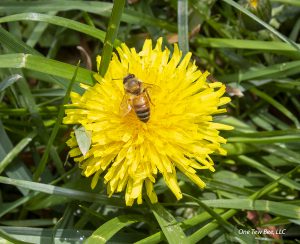
Figure 2. Why do so many dandelion blooms NOT
have pollinators visiting?
The very opposite aspect of this imprecise discussion – honey bee precision
While much of bee management recommendations may not be precise, many aspects of honey bee biology are stunningly precise – stunning. For instance, the orientation mathematics that bees use is… may I use the word again… stunning.
Frankly readers, this will be a short discussion section because the bees’ inborn ability to calculate, orient and construct are far beyond my ability to expound and discuss. For instance, scout bees leading the hoard to the new home site. How do they do that? That lone water forager bee that can find the tiny amount of water leaking from my water hose and then send others to it. How do they do that? The precision with which bee construction workers can build new hexagonal combs or how bees that are essentially blind in the dark can so easily find the successful forager that is presenting a mathematical grid (the dance) to direct recruits to the new home site or to a food source. Again, how do they do that? This Astounding List of bee innate abilities is nearly endless (In fairness, it should be said that many, many life forms possess novel behaviors and abilities – not just honey bees. But again, in fairness, honey bees are the life form that we are presently discussing).
To academically make my point, I offer a note (Frank, Adam. October 1997. Discover Magazine. Quantum Honey Bees. https://www.discovermagazine.com/planet-earth/quantum-honeybees) presented several years ago in Discover Magazine, and then I offer a second reference (Shelomi, Matan. https://www.quora.com/What-is-the-current-state-of-research-on-Barbara-Shipmans-findings-regarding-Quantum-Mechanics-and-the-Honey-Bee-waggle-dance) that refutes the concepts of the researcher’s original comments made in the magazine article. This academic interaction is beyond the scope of my present article, but this advanced discussion touches on the complexity of the bees’ natural ability that they use in their currently unexplained world.
This esoteric discussion in the technical beekeeping literature clearly makes the point that, “We don’t know what we don’t know.” I have made no serious effort to explore all avenues of this ongoing interaction that presents advanced concepts in honey bee mathematics and quantum physics – if such a type of mathematics and quantum physics even exists.
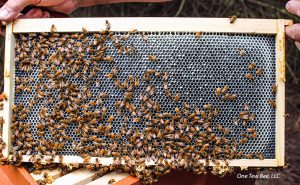
Figure 3. Look beyond basic bee management to the complex biology and mathematics quietly shown in this photo.
The imprecise precision of beekeeping
I speculate that our myriad questions and odd events in beekeeping are because our true understanding of honey bees and their ways is presently only at the elemental level.
Yes, it’s true. All of us are only beginner beekeepers – some more than others.
I can’t even tell you why Summer bees perform the washboard behavior or if forager bees know the existence of neighboring colonies so they can rob from them if the need arises. How do bees find water sources – by smell? If so, it must be a very powerful sense they have for I have had them find very small water sources. How do scouts find new home sites? Sight? Compared to my vision senses, what does the world look like to flying bees? Questions seem endless.
From intellectually afar, it would appear that bees, indeed, do have a remarkably precise lifestyle. This lifestyle only appears imprecise to us – humans – because we are still learning and exploring the tools and abilities that bees have that are fully foreign to us. We have only begun to understand.
Thanks for reading
Thank you for reading this piece. I always appreciate your time, but more importantly, thank you for thinking.
Dr. James E. Tew
Emeritus Faculty, Entomology
The Ohio State University and
One Tew Bee, LLC
[email protected]
Honey Bee Obscura podcast
https://www.honeybeeobscura.com/
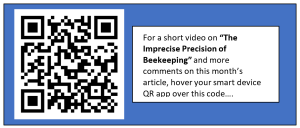 https://youtu.be/3MOFqQjNtdA
https://youtu.be/3MOFqQjNtdA
By: Priyadarshini Basu
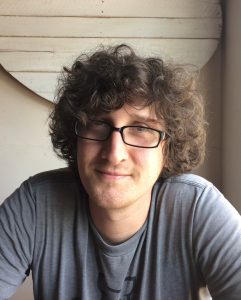
Peter Fowler
The winner of the 2022 Extension Activities Award is PhD student Peter Fowler of Michigan State University, who is advised by Dr. Meghan Milbrath. He received the $1,000 award for his proposal entitled, Diagnostics training for veterinarians working with honey bees. Funding will fill a much needed gap and support development of training for veterinary professionals to conduct diagnostic screening assays. This effort may also lead to larger funding, and so this award serves as a seed grant in this capacity.
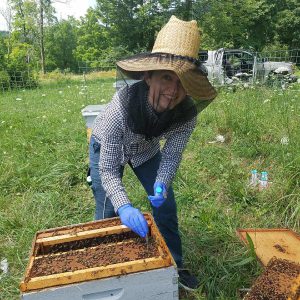
Brooke Lawrence
The winner of the 2022 award for Masters work is Brooke Lawrence, a Masters student in the Department of Entomology at Pennsylvania State University under Dr. Margarita López-Uribe. Her thesis research is entitled, The role of beekeeping management systems on microbes, pathogens, and immunity in honey bees. Her integrative research shows the importance of understanding the multifaceted impacts of management strategies on bee health and overall the continued importance of keeping varroa mites in control. Brooke’s work is impressive and we look forward to seeing where her career takes her.

Garrett Slater
The winner of the 2022 award for PhD candidates is Garett Slater from the Department of Entomology at Purdue University under Dr. Brock Harpur. His application was entitled, Using genomics to predict drone quality: Why are there so many ‘dud’ male honey bees. His research is firmly rooted in a deep understanding of drone genetics and reproductive quality with the ultimate goal of improving queen mating success and colony health. Garett’s productivity and commitment to scientific communication is exceptional.
]]>By: Laura Kraft
As gardeners become more interested in seeking out pollinator-friendly plants, the horticulture industry has a growing need to reliably measure and label plants for their ability to attract bees, butterflies, flies and other pollinators. This is particularly important for the flowering plants found most often at your local nursery, where years of hybridization and selection for certain characteristics may have influenced the plants’ attractiveness to local pollinator communities.
“There’s this disconnect between what’s labeled ‘Good for Pollinators’ and what’s actually good for pollinators,” says Emily Erickson, Ph.D., a postdoctoral researcher currently investigating population ecology at Tufts University. “There’s no real standard protocol to assessing what pollinator attractiveness means for nursery plants.”
Erickson’s postdoctoral research aims to tackle this problem. In a study she conducted with colleagues at Penn State University and published in May in the Journal of Economic Entomology, her team found that, for many plants, 10 minutes is a sufficient observation time to determine attractiveness to pollinators. Further, they found that these observations could be done successfully by even novice observers with just a little bit of training.
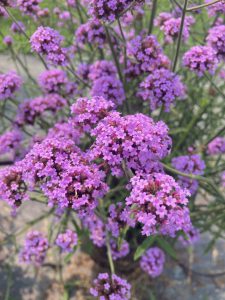
Verbena meteor shower. Photo by: Dr. Emily Erickson
Harnessing Citizen Science
Erickson is something of an expert at sitting in an oppressively hot field for hours, observing the pollinators arriving at flowers. She spent years doing exactly that during her graduate studies in the same lab group. When it came time to assess how to develop a protocol to get untrained individuals to make the same measurements that she had spent years practicing, she knew she had to ask for help. Erickson’s team found an incredibly enthusiastic group of volunteers from the local Master Gardener program.
“There’s a huge potential in this field for citizen science, but researchers can be wary of it because of concerns about observer error and data quality,” she says. In their new study, Erickson’s team set out to measure this error and to determine a minimum observation time for volunteer observers to quantify pollinator friendliness of new cultivars.
First, Erickson gave the volunteers a brief training on which pollinators they would likely encounter during the observation period but provided no additional help while volunteers observed on their own. As a comparison, Erickson’s team observed the same plant cultivars for the same periods of time to determine novice error.
The researchers also wanted to identify how long an individual plant should be observed to estimate different measures of attractiveness. To do this, Erickson watched each plant for 30 minutes and recorded which insects visited the plant and when. By spacing out observations over time and space, Erickson and colleagues learned some important parameters needed to measure pollinator attractiveness of cultivated plants.
In short, they found that a minimum observation time of 10 minutes accurately captures the pollinator visitation for a given cultivar and time of day. Furthermore, their team of Master Gardeners, despite having little to no experience observing pollinators prior, produced high quality observations after receiving a short training session.
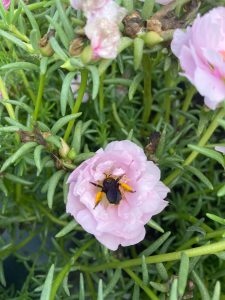
Melissodes bimaculatus on portulaca (sundial light pink). Photo by: Dr. Emily Erickson
What Makes a Plant Pollinator-Friendly?
For nursery plants, attractiveness to pollinators is often considered a static property. One of the most interesting outcomes of this research is showing that plant attractiveness appears to change based on the time of day or other factors, such as what other plants are in the vicinity. In one dramatic example, the observers noticed that the flowers of Portulaca ‘Sundial Light Pink’ would open in the morning and close in the afternoon. Observers didn’t notice many pollinators visiting these flowers at all. As Erickson recalls, “I kept thinking I’m not going to get anything to this [flower]. I sat out there for 30 minutes and saw one syrphid fly. Then one day I show up and it was covered with the Melissodes bimaculatus.” Based on these observations, Portulaca ‘Sundial Light Pink’ appeared to be a cultivar that provides an inconsistent reward for pollinators and would not be suitable to be labeled ‘Pollinator-Friendly.’
In contrast, other flower cultivars had high pollinator abundance throughout the observation period. They seemed less affected by other background factors like time of day or nearby plants. These cultivars, which have consistent rewards for pollinators, would likely be more suitable candidates for the title of pollinator-friendly plants.
Additionally, Erickson’s group found that merely looking at pollinator abundance is an insufficient measure of pollinator attractiveness, since cultivars that attract different groups of pollinators tend to attract different numbers of visitors overall. For example, flowers in the study that attract mostly bees received many more visits in 30 minutes than those that attracted mostly flies or butterflies. If total visitor abundance is the only measure considered, an assessment of plant attractiveness may undervalue cultivars that provide resources to more diverse pollinators. Says Erickson, “I think just broadening our understanding of what plant value means beyond just ‘How many things overall does it attract?’ is a really important consideration going forward.”
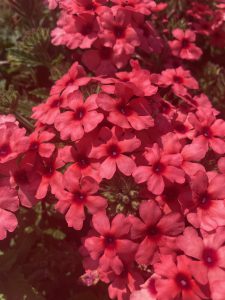
Verbena Lascar ‘Mango Orange.’
Photo by: Dr. Emily Erickson
Developing Solutions for the Floriculture Industry
Erickson’s team worked closely with members of the floriculture industry when designing this research in the hopes of developing a standardized protocol that can be used to label new cultivars appropriately. The hope is that, in the future, pollinator attractiveness can be measured among other traits in breeding trials of new flower cultivars, allowing for more meaningful labeling to be used.
This will help gardeners and urban planners choose flower cultivars suited to supporting urban and residential pollinator habitats, particularly since cultivars, like fast fashion, are quickly replaced by the latest and greatest new blooms and often cannot be found again the next growing season.

Laura Kraft

Dr. Emily Erickson
Laura Kraft, Ph.D., is an entomologist, science communicator and world traveler currently based in Orlando, Florida. Email: [email protected].
Photo Caption: The authors found significant differences in pollinator activity to closely related cultivars of flowers. For example, Verbena ‘Meteor Shower’ received lots of bee and butterfly visitors while Verbena Lascar ‘Mango Orange’ received very few visitors.
Originally published at the Entomological Society of America’s blog, Entomology Today.
]]>By: Savannah Christiansen (Pollinator Partnership), Anne Marie Fauvel (Bee Informed Partnership) & Nathalie Steinhauer (Bee Informed Partnership)
Bee Informed Partnership (BIP) is fond of collaborating with beekeepers, organizations and institutions. These collaborations are a kind of superpower, a great way to come up with ideas, support and implement them always with the goal of generating more impact. BIP’s collaboration with the Pollinator Partnership is one such example.
Pollinator Partnership is the largest organization dedicated exclusively to the conservation, education and research of pollinating animals and their habitats. Founded in 1997, their team of staff scientists has conducted numerous research studies on key questions and concerns in land management, agriculture and wildland conservation. With this science-based understanding at the forefront of their work, Pollinator Partnership has been cognizant of threats facing honey bees for many years including the impacts of the Varroa destructor mite on colony health. In order to spread awareness about monitoring for the Varroa mite, Pollinator Partnership got together with the MiteCheck team, including the Bee Informed Partnership, University of Maryland, University of Minnesota and Michigan State University to launch the North American Mite-A-Thon beginning in 2017. The group worked together to identify key priorities, gaps in knowledge and logistics for a continent-wide education, awareness and data collection campaign around monitoring hives for mite levels.
The Mite-a-thon is now an established, tri-national citizen science effort between Canada, the United States and Mexico to collect Varroa destructor infestation data in honey bee colonies. During two weeks in the Spring and another two in the Fall, beekeepers are encouraged to test for the number of mites in their hives using two common methods for monitoring (alcohol wash or powdered sugar roll) and upload that data into a website and app called Mitecheck to be compiled and analyzed. While Mite-A-Thon is not meant to be a rigorous scientific study, this citizen science project is meant to educate beekeepers, particularly non-commercial beekeepers, about effective monitoring methods for Varroa as part of overall colony health. Through participation, beekeepers also learn about different management practices from one of the many treatments available to no treatment at all. That said, Mite-A-Thon doesn’t take any one point-of-view on management practices, that is up to each individual beekeeper.
Now in its sixth year, the Mite-A-Thon has reached an estimated 2,570 unique participants and tested 1,018 colonies since its inception in 2017. Over the years, Mite-a-Thon has seen more beekeepers answering the question about management practices, which may have contributed to participants being more aware about treatment methods. As for longer-term survival, the level of Varroa destructor infestation at the end of the season is a pretty good indicator of overwintering losses. Though it is just one of the factors that can influence overwintering survival, it is really important to help beekeepers have an idea of what lies ahead based on their late season infestation levels. That said, each year has seen a high percentage of new participants, revealing that, beekeepers gain new knowledge and skills they can use towards maintaining colony health. Mite-A-Thon has also provided a platform for beekeeping associations to engage new members in their organizations and reconnect with long-time members to re-familiarize them with proper Varroa monitoring techniques.
This year the Mite-A-Thon is continuing with another two sessions for Varroa monitoring. One took place in the Spring, from April 30 – May 15, 2022 and the second will take place in the Fall, from August 13 – August 28, 2022. This August, all beekeepers in North America are encouraged to participate. You can do so by using either the powdered sugar roll or alcohol wash method to record the number of mites in each colony you test and upload those results to www.mitecheck.com. The more participants, the more data available for Pollinator Partnership and its partners to use in their work towards the protection of honey bees, along with growing a stronger network for beekeepers to connect and share information.
The Pollinator Partnership and Bee Informed Partnership invite YOU to collaborate and participate in the 2022 Mite-A-Thon this month. On your mark, get set, mitecheck!
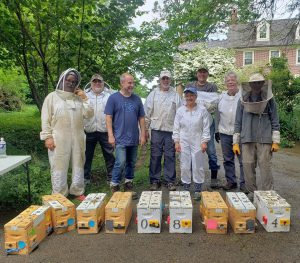
The Chester County Beekeepers Association, a group which helped propel Pennsylvania into the state with most participants in 2020, poses with their hives after the Mite-A-Thon.
Photo credit: Chester County Beekeepers Association
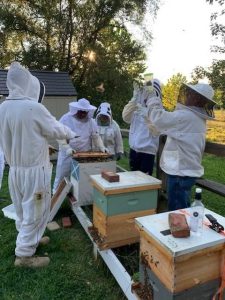
Members of the Chester County Beekeepers Association begin the testing process to monitor for Varroa mites in their honey bee colonies. Photo credit: Chester County Beekeepers Association